Learning’s About to Leap Again
Posted on March 30, 2010
Filed Under Technology | Leave a Comment
This could be one of the most important weekends since Johannes Gutenberg announced the invention of moveable type 570 years ago. And, says Wikipedia, Gutenberg’s breakthrough for learning the world over is “widely regarded (as) the most important event of the modern period.” The printing press greatly abetted, if not launched, the Renaissance, Reformation and the Scientific Revolution which, of course, gave rise to modern times.
Well, Apple Computer’s iPad goes on sale Friday. Don’t scoff when we compare the shiny tablet to Gutenberg’s new printing technology. The more people learn about the iPad, the more excited they seem to become about it. At first as Steve Jobs announced the device in January, Daniel Lyons recalls in the cover story of this week’s Newsweek, “it seemed like no big deal. It’s a bigger version of the iPod Touch, right? Then I got a chance to use an iPad, and it hit me, I want one.”
 A lot of people who haven’t tried an iPad yet seem to feel the same way. One estimate is that 200,000 of them will be sold this weekend. That’s not only significant for Apple, but for literacy in our time. Why? Because ebooks, led possibly by the iPad, are likely to make electronic learning common, and perhaps more successful than paper-based instruction, in classrooms and households around the world. (Amazon bought Newsweek’s back cover to promote its own Kindle ereader, probably in hopes of keeping abreast of Apple.)
A lot of people who haven’t tried an iPad yet seem to feel the same way. One estimate is that 200,000 of them will be sold this weekend. That’s not only significant for Apple, but for literacy in our time. Why? Because ebooks, led possibly by the iPad, are likely to make electronic learning common, and perhaps more successful than paper-based instruction, in classrooms and households around the world. (Amazon bought Newsweek’s back cover to promote its own Kindle ereader, probably in hopes of keeping abreast of Apple.)
You can not only read books but watch movies, play games, listen to music, send email and sort photographs on the battery-powered iPad. And it only needs to be in your lap, not on a desktop. (We haven’t heard yet whether you’ll be able to print from the touch keyboard, but we suspect so. If not now, soon.)
Think what the iPad and other tablet approaches to reading and learning mean. They bring together all the excitement that youngsters have been experiencing growing up with computers and the Internet, all the new windows they have on the world. And it’s fun, exhilarating actually, to open and use them.
What might that do for further learning and creativity? Stick around a while, please do. This new era isn’t to be missed.
“There’s a wholesale transition building steam around the way content is distributed and then accessed by students and teachers, and there are multiple formats, multiple devices and multiple distribution channels,” Rik Kranenburg, president of the higher education, professional, and international group at McGraw-Hill Education says in the April EContent magazine.
“The combination of print and digital offerings does very impressive things,” Kranenburg adds “It opens up new opportunities to make instruction and study more effective, more efficient and more personalized.”
A lot of wood carvers and wielders of ink brushes were probably thinking much the same thing in Johannes Gutenberg’s day. Questions remain about how ebooks will be gotten into the hands of people everywhere, but the first typeset books didn’t circulate widely either.
Incidentally, Seton Hill University in Greensburg, Pa., is providing each of its full-time students with an iPad and a 13″ MacBook laptop – screens in the wind? – Doug Bedell
‘Augmented Reality’ On the Highways
Posted on March 19, 2010
Filed Under Technology, Uncategorized | Leave a Comment
We practically launched Insights with a post about electric cars and our hopes that Chevrolet’s Volt will indeed be launched in November. Now here’s Guy Kawasaki test-driving a Volt at the SXSW new media conference in Austin.
It runs! It handles nicely! Its approximate range will be 400 miles on an eight-gallon tank of gas and the electric motor will always power the car! This last is a reference to the Volt being a “series” hybrid. Existing hybrids are “parallel” vehicles – “the electric motor powers the car for low speeds, and the gasoline engine kicks in for greater acceleration and higher speeds,” Kawasaki advises.
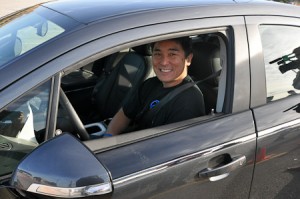 It’s interesting (though dismaying) to note that the Volt test-driving was done in the parking lot of an Austin shopping mall where most of the stores were out of business – a hapless setting not unlike Detroit itself.
It’s interesting (though dismaying) to note that the Volt test-driving was done in the parking lot of an Austin shopping mall where most of the stores were out of business – a hapless setting not unlike Detroit itself.
With electric cars, though, we may be at the symbolic juncture of two eras in the U.S.: the decline of the old manufacturing economy and the rise of a new innovation-powered one that’s good for renewed production of industrial goods and jobs. We certainly need that kind of good fortune. And we’re wishing the Volt all success (at a reasonable price, of course).
Now, if electrically-powered transmission can be coupled with GM’s new “augmented reality windshield” we may really have something! GM says the new windshield can highlight landmarks, obstacles and road edges before a driver’s eyes, in real time. It can point out to drivers potential hazards, such as a running animal, even in foggy or dark conditions.
Boy, that would be great. Maybe “augmented reality” can even catch sight of a revived, prosperous and reliable industrial economy for us all. Right on at the new GM! – Doug Bedell
A Green Brownfield… Now that’s an Idea Worth Pursuing!
Posted on March 16, 2010
Filed Under Business, Technology | Leave a Comment
Whenever engineers gather—particularly engineers whose hairlines are either receding or tinged with gray—the conversation often turns to the sad state of infrastructure renewal in this country. Those engineers recall the “old days” when either they or their fathers (sorry, very few female engineers in those days) worked on large projects that were actually conceived, approved, and built on budget and on schedule.
The contract for Hoover Dam was awarded in 1931 and the dam was dedicated in 1935, two years ahead of schedule and about $15,000,000 (30%) under budget. Imagine trying to obtain approval today for that project, or for the approximately 47,000 mile Interstate Highway System, a national treasure that accounts for about one-third of all miles Americans drive. Today we are hard-pressed to build a much needed power plant (green or not) or bridge, let alone something of real national significance (such as Yucca Mountain… billions spent for naught).
 Perhaps a new push by the EPA and DOE will help reverse this dreadful record, at least for some of the less controversial infrastructure projects. According to an Energybiz Insider article, those agencies are considering regulations to encourage renewable energy plants (solar, wind, and hydro) on brownfields, that is, contaminated and abandoned industrial sites. Every state has such sites, and they total about 450,000 acres in the U.S.
Perhaps a new push by the EPA and DOE will help reverse this dreadful record, at least for some of the less controversial infrastructure projects. According to an Energybiz Insider article, those agencies are considering regulations to encourage renewable energy plants (solar, wind, and hydro) on brownfields, that is, contaminated and abandoned industrial sites. Every state has such sites, and they total about 450,000 acres in the U.S.
The article cites a few such success stories, including an abandoned steel mill in New York that is now home to a wind farm, and a U.S. Army facility in Colorado where solar electric panels have been installed. One hopes that even the hardcore NIMBYs might prefer a green energy power plant—however modest in output—to an abandoned, chemical-laden brownfield in their communities. Then again, if the chemical soup on the site caused algae to mutate into a deadly new life form I’m sure there would be intervenors carrying “Save the Scum” placards. — Dennis Owen
View Earth’s Climate Prudently
Posted on March 12, 2010
Filed Under Technology | Leave a Comment
The debate over climate change troubles me, especially now that the doubters seem to be gaining. But I don’t hold to the irritating “conclusion” reached by Bill Chameides, Dean of Duke University’s Nicholas School of the Environment and a member of the Natonal Academy of Sciences, who presents some of the latest poll findings on The Huffington Post.
Noting that “America has experienced a cool patch of late,” Chameides writes that “Some scientists have conjectured that it has something to do with the jet stream. But what do they know? I think it could be due to the Tea Party. With all their speechifying, finger-wagging, and chanting, they may have used up all of the nation’s hot air. ”
 That sounds pretty undeanly to me. The problem with climate change is that it’s a long-term trend, not immediately measurable in any conclusive way. And that sort of reassuring evidence seems to be what many of us want.
That sounds pretty undeanly to me. The problem with climate change is that it’s a long-term trend, not immediately measurable in any conclusive way. And that sort of reassuring evidence seems to be what many of us want.
I write as a spring rain washes away the last of a huge pile of snow we’ve had out front for weeks now. We’ve had a rough winter here in Central Pennsylvania. But that, in itself, doesn’t say anything decisive about whether the climate is heating up or cooling down. We’ve got to be patient about scientific things.
More importantly, when a dispute involves the state of the entire planet and its atmosphere we have to err on the side of caution. That is, we should be acting as if the climate is heating up, even if we can’t be completely sure that it is. (Even though most scientists, apparently, would argue about that.) The risks if we do little or nothing and the scientific consensus is correct are just too great. Prudence matters more than emotions.
If we limit emissions of greenhouse gases, we have a cleaner environment, whether or not icebergs keep melting. That’s a plus we should all be willing to share in achieving.
I wrote the other day on another blog that monitoring climate research calls for “the most enlightened public relations project ever.” I suggested that a website like Solveclimate.com might be the answer. I didn’t know then about NOAA’s “State of the Climate” site, though it may not be focused enough.
I appreciate, however, Bill Chameides making me aware of the NOAA site. That’s the best we can do for all of us – make information available, think prudently and take steps to improve the quality of our environment, whatever Earth’s long-term fate may be. – Doug Bedell
NASA Needs New Rockets
Posted on March 9, 2010
Filed Under Technology | Leave a Comment
NASA exists to satisfy a national travel itch – we want to explore space and NASA’s rockets are the means of doing so. The problem is, there are only a few celestial destinations we’ll be able to reach in the next few decades. And NASA needs not so much a map as a method to get to them.
President Obama wants to develop better rocketry before heading off again to the moon, or to somewhere else reachable in space, perhaps an asteroid and, ultimately, Mars. Truly, this is a high technological challenge.
As The Washington Post recently reported, “future space flight, NASA officials say, now depends on new rocket science and where it can take us.”
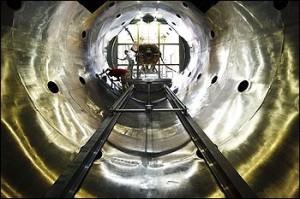 So NASA needs not to be wistful, but extra ingenious. Practicality never counted for so much in technological terms. If we’re going to venture further into space, we need better rockets. Our reach into space depends on getting better, ever more ingenious, technically.
So NASA needs not to be wistful, but extra ingenious. Practicality never counted for so much in technological terms. If we’re going to venture further into space, we need better rockets. Our reach into space depends on getting better, ever more ingenious, technically.
Like the original moon program itself, space is challenging our technical genius. We reach new frontiers, now, by having better propulsion systems. If we don’t come up with them, we stay home.
Maybe we should stay home anyway, some will say. But the space program has always been a key means of technical progress, with developments in space exploration being adapted and dispersed for everyday use.
So good luck on those rockets, NASA, and anyone else who can help us explore the universe. We’re getting really itchy again for extraterrestrial travel.
– Doug Bedell
Lost Jobs Aren’t Being Replaced
Posted on February 23, 2010
Filed Under Technology | 1 Comment
Truly ominous confirmation of our post on ebbing U.S. innovation comes from a New York Times article, “Millions of Unemployed Face Years Without Jobs.”
How is The Times able to deliver this news of the “new poor”? A consensus is developing among economists that the recovery from this recession “will leave more people behind than in past recessions, failing to create jobs in sufficient numbers to absorb the record-setting ranks of the long-term unemployed.”
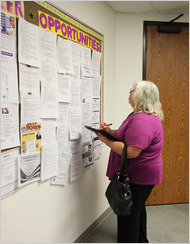 And that has much to do with the lagging U.S. rate of development in science and technology, along with turning technological thinking into new U.S.-based businesses and jobs.
And that has much to do with the lagging U.S. rate of development in science and technology, along with turning technological thinking into new U.S.-based businesses and jobs.
There are now 6.3 million Americans who have been unemployed for six months or longer, “the largest number since the government began keeping track in 1948. That is more than double the toll in the next-worst period, in the early 1980s.”
Schools, colleges and workplaces that are unable to attract more young people into science and technology will see them, instead, waiting haplessly on unemployment lines. This is a truly frightening prospect, the dark side of the American dream when it falters.
“Every downturn,” notes The Times, “pushes some people out of the middle class before the economy resumes expanding. Most recover. Many prosper. But some economists worry that this time could be different. An unusual constellation of forces — some embedded in the modern-day economy, others unique to this wrenching recession — might make it especially difficult for those out of work to find their way back to their middle-class lives.”
We have exported job opportunities and are losing our technological edge against the countries where those jobs have gone. Truly a double whammy, unless we start thinking Sputnik-like and figure out how to do more technically-grounded work at home. We need a renewed job market, and it won’t come quickly. – Doug Bedell
U.S. Ebbing in Science and Engineering
Posted on February 22, 2010
Filed Under Technology | 1 Comment
Are we gaining or losing ground in science and engineering, key sources of innovation and that quintessential American ideal, progress? Either way, by how much?
Not easy to tell, you say? Nothing more than a hunch would be involved? Maybe so…unless you dig into the recently released Science and Engineering Indicators 2010. The National Science Board (NSB) – the governing body for the National Science Foundation (NSF) and NSF’s Division of Science resources Statistics – works this report up every two years.
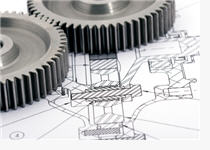 (We’re indebted to ThomasNet for bringing the NSF report to our attention on its Industry Market Trends (IMT) blog. IMT is a great place to keep abreast of trends in engineering – projects, education, funding and other key material.)
(We’re indebted to ThomasNet for bringing the NSF report to our attention on its Industry Market Trends (IMT) blog. IMT is a great place to keep abreast of trends in engineering – projects, education, funding and other key material.)
Unfortunately, the NSF report verifies that, what to many of us is a hunch, is actually a worrisome reality. “The latest edition indicates that while the state of U.S. science and engineering is strong, ‘U.S. dominance has eroded significantly’ in recent years, due in large part to rapidly increasing capabilities among Asian nations, particularly China, Kei Koizumi, assistant director for federal R&D in President Obama’s Office of Science and Technology Policy, said in an announcement of the findings.”
“‘The data begin to tell a worrisome story,'” Koizumi said.
The findings are listed in greater detail on the ThomasNet blog. But they include a declining U.S. share of R&D activity, lagging student interest in studying natural sciences and engineering, and impressive increases in entry-level natural sciences and engineering degrees in the developing world, including China (leading, of course).
From a U.S. perspective, the trends aren’t great, either, in science and engineering doctorates, research articles published and U.S. patents awarded to foreign inventors.
It does appear, though, that a “large proportion” of the foreign Ph.D. recipients at U.S. universities will stay here, if we keep encouraging them to do so. “Sixty percent of temporary visa holders who had earned a U.S. science and engineering Ph.D. in 1997 were gainfully employed in the U.S in 2007, the highest 10-year stay rate ever observed.”
We all have our own notions of what’s diverting American youngsters from the sciences and engineering– often, it seems, from concentrating notably anywhere at all. (Except, apparently, in Olympic sports.) But if the momentum that science and engineering give our economy is to pick up, educators, parents and employers need to become familiar with what’s occurring at U.S. schools and help them renew the appeal of rigorous subjects like math, science and engineering. – Doug Bedell
The Latest Airship Vision – an Elegant Floating Hotel
Posted on February 15, 2010
Filed Under Technology | 1 Comment
We’re still imagining new ways to float through the skies in airships. Korean Samsung Construction and Trading (Samsung C&T) is investing in the Seymourpowell Aircruise to further its interest in exotic materials.
Exotic this airship surely is – much more, for instance, than a dirigible with a cabin suspended below. “The initial design,” says a Seymourpowell.com release, “proposes a bar/lounge zone, four duplex apartments, a penthouse and five smaller apartments.” It would be a hotel in the skies, traveling leisurely across oceans or wherever its “residents” wanted to go.
 Whether it will ever be reach commercial scale is doubtful, says the MetalMiner blog. But dreams and visions don’t necessarily have to be scaled-up – the Aircruise already exists in this YouTube video. (The lovely accompanying music, alone, will transport you.)
Whether it will ever be reach commercial scale is doubtful, says the MetalMiner blog. But dreams and visions don’t necessarily have to be scaled-up – the Aircruise already exists in this YouTube video. (The lovely accompanying music, alone, will transport you.)
There is something entirely peaceful and benign, if very expensive, about this craft, which would be lifted by hydrogen and powered by solar energy. The details are in the links included here. The vision, as always with visions, is what matters most. – Doug Bedell
My Wine Experiment
Posted on February 9, 2010
Filed Under Technology | 1 Comment
I enjoy wine. But being a graduate of FPU I’m a cheapskate at heart. It’s particularly disheartening to spend my hard earned dollars on an untried bottle and then be disappointed. This means that—given the vast world of wine out there—I tend to be unadventurous and stick with the familiar… boring!
Some recent reading about a relatively new company called First Flavor has prompted me to embark on a simple experiment. First Flavor manufactures taste strips for consumer products in an effort to give customers a point-of-purchase opportunity to taste their clients’ wares. Rum, vodka, tequila, smoothies, fruit drinks, and toothpaste taste strips are among their offerings… why not wine?
Aficionados will laugh at the notion that the subtle characteristics of fine wine will translate to a paper (or other edible substrate) you pop in your mouth. Probably, but to an engineer it is certainly worthy of a quick and dirty experiment. My first stop was a research article on brain response to odor and taste, which gives a little insight into preparing such strips. Next I need to find edible paper for the substrate… hmm, do I have to order rice paper from China? Instead I try the next best thing, and sure enough, I can order edible paper from Amazon! (Books, DVDs, iPods, and edible paper… makes perfect sense to me.)
 Now the wine. Well it turns out I have a cousin in California who is one of the state’s premier growers of hard-to-find Iberian (mainly Portuguese) wine grapes. Ron, if you are reading this air freight a case of Alta Mesa Verdelho and Tempranillo ASAP… it’s tax deductible as an R&D expense. After preparing some taste strips and checking them against the real thing (eat a taste strip drink a case, eat another taste strip drink another case, etc.) I’ll report back. Stay tuned. – Dennis Owen
Now the wine. Well it turns out I have a cousin in California who is one of the state’s premier growers of hard-to-find Iberian (mainly Portuguese) wine grapes. Ron, if you are reading this air freight a case of Alta Mesa Verdelho and Tempranillo ASAP… it’s tax deductible as an R&D expense. After preparing some taste strips and checking them against the real thing (eat a taste strip drink a case, eat another taste strip drink another case, etc.) I’ll report back. Stay tuned. – Dennis Owen
Robots Gaining in ‘Muscles,’ Dexterity
Posted on February 9, 2010
Filed Under Technology | 1 Comment
They’re not yet Captain Marvel but, by gosh, they’re getting close, at least in their upper bodies. New industrial robots being developed jointly by NASA and General Motors have amazing dexterity in their arms and even their fingers.
NASA and GM are working together on this next generation of robots because they have applications both for exploring space and building cars. They’re called Robonaut 2, or R2. The original Robonaut is 10 years old now.
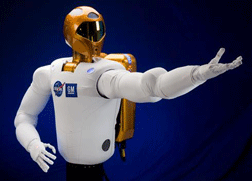 R2 looks almost musclebound. It can lift 20 pounds with each arm, “about four times that of other humanoid robots,” says NASA. Robots have long been used in the auto industry, of course. Perhaps at some point Robonaut 2 could be introduced to Ford’s RUTH, which does interior work on Ford vehicles, but so far without having a humanoid look. I wonder what that mating might yield?
R2 looks almost musclebound. It can lift 20 pounds with each arm, “about four times that of other humanoid robots,” says NASA. Robots have long been used in the auto industry, of course. Perhaps at some point Robonaut 2 could be introduced to Ford’s RUTH, which does interior work on Ford vehicles, but so far without having a humanoid look. I wonder what that mating might yield?
R2’s “legs” at this point may be only a pedestal. But who knows about future generations and what their builders might need in terms of robotic assistance – like hiking on the moon or mars.
Robonaut is an impressive contrast to some earlier industrial robots of which we have first- hand knowledge. In the 1980s and ’90s we were involved in the recovery program for the Three Mile Island Unit 2 nuclear power plant after the 1979 accident there. Several robots were developed to deal with cleanup and disassembly tasks in high radiation areas unsafe for human work. Most of those were designed and built at the Robitics Institute at Cernegie Mellon University under the direction of the brilliant William (Red) Whittaker, or at his spinoff company RedZone Robotics. By today’s standards they were rather primitive beasts (see photo nearby).  Some were quite successful (reactor internals disassembly) while others were largely expensive failures (removing radioactive sludge from the reactor building basement).
Some were quite successful (reactor internals disassembly) while others were largely expensive failures (removing radioactive sludge from the reactor building basement).
Nonetheless, these and thousands of others are all part of the robot lineage that have taken us to Robonaut 2, RUTH, and more. Like the Apollo astronauts, when Robonaut’s descendants walk on Mars, we wonder if they will use their telescopic vision to look at a pinpoint of light in the heavens and dream of home. – Doug Bedell
« go back — keep looking »Recently
- Presentations With Forethought
- Technical Writing’s Lineage – Surely It’s Deeper than Digital
- At the Holidays, Twitting Amazon
- Successful Cookie Baking – From Mom, an Acknowledged Expert
- Slides for a Tech Writer’s Craft
- Digital or Not, Be Clear
- Being Watchful About Digital Designs…
- When Proposals Don’t Click, Keep Making Them Anyway
- Like a Good Gardener, Help an Enterprise Keep Itself Current
- We’re Leaders All, And Need to Think That Way
Categories
Archives
- January 2017
- December 2016
- November 2016
- October 2016
- September 2016
- August 2016
- July 2016
- June 2016
- May 2016
- April 2016
- March 2016
- February 2016
- January 2016
- December 2015
- November 2015
- October 2015
- September 2015
- August 2015
- July 2015
- June 2015
- May 2015
- April 2015
- March 2015
- February 2015
- January 2015
- December 2014
- November 2014
- October 2014
- March 2014
- February 2014
- January 2014
- December 2013
- November 2013
- October 2013
- September 2013
- August 2013
- July 2013
- June 2013
- May 2013
- April 2013
- March 2013
- February 2013
- January 2013
- December 2012
- November 2012
- October 2012
- September 2012
- August 2012
- July 2012
- June 2012
- May 2012
- April 2012
- March 2012
- February 2012
- January 2012
- December 2011
- November 2011
- October 2011
- September 2011
- August 2011
- July 2011
- June 2011
- May 2011
- April 2011
- March 2011
- February 2011
- January 2011
- December 2010
- November 2010
- October 2010
- September 2010
- August 2010
- July 2010
- June 2010
- May 2010
- April 2010
- March 2010
- February 2010
- January 2010